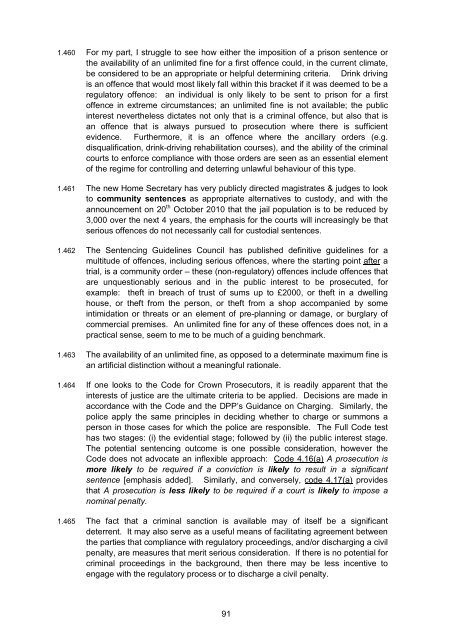Criminal Liability in Regulatory Contexts Responses - Law ...
Criminal Liability in Regulatory Contexts Responses - Law ...
Criminal Liability in Regulatory Contexts Responses - Law ...
You also want an ePaper? Increase the reach of your titles
YUMPU automatically turns print PDFs into web optimized ePapers that Google loves.
1.460 For my part, I struggle to see how either the imposition of a prison sentence or<br />
the availability of an unlimited f<strong>in</strong>e for a first offence could, <strong>in</strong> the current climate,<br />
be considered to be an appropriate or helpful determ<strong>in</strong><strong>in</strong>g criteria. Dr<strong>in</strong>k driv<strong>in</strong>g<br />
is an offence that would most likely fall with<strong>in</strong> this bracket if it was deemed to be a<br />
regulatory offence: an <strong>in</strong>dividual is only likely to be sent to prison for a first<br />
offence <strong>in</strong> extreme circumstances; an unlimited f<strong>in</strong>e is not available; the public<br />
<strong>in</strong>terest nevertheless dictates not only that is a crim<strong>in</strong>al offence, but also that is<br />
an offence that is always pursued to prosecution where there is sufficient<br />
evidence. Furthermore, it is an offence where the ancillary orders (e.g.<br />
disqualification, dr<strong>in</strong>k-driv<strong>in</strong>g rehabilitation courses), and the ability of the crim<strong>in</strong>al<br />
courts to enforce compliance with those orders are seen as an essential element<br />
of the regime for controll<strong>in</strong>g and deterr<strong>in</strong>g unlawful behaviour of this type.<br />
1.461 The new Home Secretary has very publicly directed magistrates & judges to look<br />
to community sentences as appropriate alternatives to custody, and with the<br />
announcement on 20 th October 2010 that the jail population is to be reduced by<br />
3,000 over the next 4 years, the emphasis for the courts will <strong>in</strong>creas<strong>in</strong>gly be that<br />
serious offences do not necessarily call for custodial sentences.<br />
1.462 The Sentenc<strong>in</strong>g Guidel<strong>in</strong>es Council has published def<strong>in</strong>itive guidel<strong>in</strong>es for a<br />
multitude of offences, <strong>in</strong>clud<strong>in</strong>g serious offences, where the start<strong>in</strong>g po<strong>in</strong>t after a<br />
trial, is a community order – these (non-regulatory) offences <strong>in</strong>clude offences that<br />
are unquestionably serious and <strong>in</strong> the public <strong>in</strong>terest to be prosecuted, for<br />
example: theft <strong>in</strong> breach of trust of sums up to £2000, or theft <strong>in</strong> a dwell<strong>in</strong>g<br />
house, or theft from the person, or theft from a shop accompanied by some<br />
<strong>in</strong>timidation or threats or an element of pre-plann<strong>in</strong>g or damage, or burglary of<br />
commercial premises. An unlimited f<strong>in</strong>e for any of these offences does not, <strong>in</strong> a<br />
practical sense, seem to me to be much of a guid<strong>in</strong>g benchmark.<br />
1.463 The availability of an unlimited f<strong>in</strong>e, as opposed to a determ<strong>in</strong>ate maximum f<strong>in</strong>e is<br />
an artificial dist<strong>in</strong>ction without a mean<strong>in</strong>gful rationale.<br />
1.464 If one looks to the Code for Crown Prosecutors, it is readily apparent that the<br />
<strong>in</strong>terests of justice are the ultimate criteria to be applied. Decisions are made <strong>in</strong><br />
accordance with the Code and the DPP’s Guidance on Charg<strong>in</strong>g. Similarly, the<br />
police apply the same pr<strong>in</strong>ciples <strong>in</strong> decid<strong>in</strong>g whether to charge or summons a<br />
person <strong>in</strong> those cases for which the police are responsible. The Full Code test<br />
has two stages: (i) the evidential stage; followed by (ii) the public <strong>in</strong>terest stage.<br />
The potential sentenc<strong>in</strong>g outcome is one possible consideration, however the<br />
Code does not advocate an <strong>in</strong>flexible approach: Code 4.16(a) A prosecution is<br />
more likely to be required if a conviction is likely to result <strong>in</strong> a significant<br />
sentence [emphasis added]. Similarly, and conversely, code 4.17(a) provides<br />
that A prosecution is less likely to be required if a court is likely to impose a<br />
nom<strong>in</strong>al penalty.<br />
1.465 The fact that a crim<strong>in</strong>al sanction is available may of itself be a significant<br />
deterrent. It may also serve as a useful means of facilitat<strong>in</strong>g agreement between<br />
the parties that compliance with regulatory proceed<strong>in</strong>gs, and/or discharg<strong>in</strong>g a civil<br />
penalty, are measures that merit serious consideration. If there is no potential for<br />
crim<strong>in</strong>al proceed<strong>in</strong>gs <strong>in</strong> the background, then there may be less <strong>in</strong>centive to<br />
engage with the regulatory process or to discharge a civil penalty.<br />
91
















